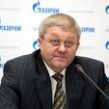
Gazprom Executive Confirms Production and Investment Woes
Publication: Eurasia Daily Monitor Volume: 6 Issue: 118
By:

Briefing the press on June 16 in Moscow, Gazprom deputy chairman Aleksandr Ananenkov lifted a curtain corner on the company’s investment and output prospects in the short-to-medium term (Interfax, June 17). Gazprom is set to substantially reduce capital expenditures in the next few years, starting with a 22 percent capex cut this year: from 640 billion rubles in 2008 to a target figure of 500 billion rubles in 2009.
Moreover, Gazprom plans to reduce production in the same short-to-medium term frame, from the 550 billion cubic meters (bcm) of gas extracted in 2008 to 523 bcm anticipated for 2012. In the short term, these measures are responding to lower international demand for gas in the midst of a recession. In the medium term, however, the cuts in production and capital expenditures reflect Gazprom’s own difficulties, including: main fields approaching the stage of depletion, chronic failure to open new fields, shortage of investment capital, losses incurred on the internal market, and the debt burden.
Gazprom’s liquidity problems are worsening at least in the short term. International gas prices are set to fall even further as of July 1, due to the nine-month lag between the oil price curve and the price of gas. This would seem to lengthen Gazprom’s time-out on investments in the production and transportation of gas.
The capital expenditures cut is immediately affecting Bovanenkovo. Ranked as Russia’s largest gas development project since the end of the Soviet era, Bovanenkovo is the richest proven deposit on the Yamal peninsula. Delayed year after year due to insufficient capital investment, the target date for the start of commercial production at Bovanenkovo is now being postponed by another year, to the third quarter of 2012 (clearly not a hard and fast date either). This onshore field had been regarded as key to overcoming the stagnation and incipient decline in Gazprom’s export potential relevant to Europe. With this project delayed again, and the offshore Shtokman field not coming any closer to the start of development, Gazprom’s export capacity and its revenues look set to decline steadily from this year onward for an undetermined period of time.
Ananenkov also cast further doubt (unwittingly or otherwise) on Gazprom’s South Stream pipeline project. He noted that the project necessitates laying some 2,000 kilometers of pipeline at an additional cost of $1 billion to $1.5 billion (Kommersant, June 17). This figure appears to come on top of previously cited cost estimates, which Gazprom had acknowledged to be incomplete. Thus, Gazprom vice-president Aleksandr Medvedev had estimated the cost of South Stream in the range of $19 billion to $24 billion in February of this year, already a totally prohibitive cost.
Gazprom is being forced to up the ante on costs because of the political decision to keep gas supply promises (as distinct from commitments) through the planned South Stream pipeline system. During 2008, Russia was promising 30 bcm per year in future supplies; in February 2009 Gazprom increased the promise to 46 bcm per year; and the Russian government upped it further in May to 63 bcm per year. These mounting promises would presuppose corresponding increases in the South Stream pipelines’ capacity; hence the two parallel upward revisions in gas volumes and pipeline costs.
Such projections form part of the political game surrounding South Stream. Moscow is trying to maximize the number of putative customer countries for South Stream gas along the pipeline route -offering even pipeline extensions to nearby countries- in an attempt to start a bidding contest among all these countries for limited amounts of available Russian gas, which are almost certainly far below those recently declared.
Gazprom’s outlook in eastern Siberia seems almost as murky. According to Ananenkov, the giant Kovykta gas field in Irkutsk Oblast will not come on stream commercially by 2017 as had been intended, but at some unspecified later date. A determination is supposed to be made after 2012 regarding the export destination for Kovykta gas. Those future options include: connecting that field with Russia’s Single Gas Supply System for ultimate export to Europe; or supplying the Irkutsk Oblast with gas; or exporting to China (the original intent a decade ago). In 2007, Russian authorities had pressured BP into agreeing to sell TNK-BP’s majority stake in the Kovykta project to Gazprom. The agreement was signed and the transaction was due to take final effect in 2008, but the actual situation seems unclear (ITAR-TASS, June 17).




